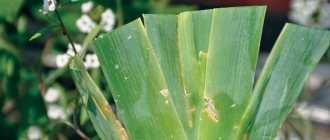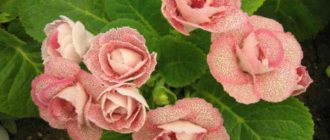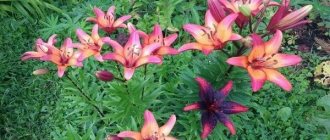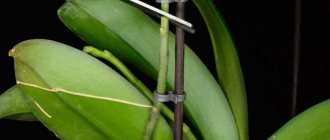Irises are a bright decoration for many flower beds. They are in demand and popular among gardeners. In total there are more than 800 species. Therefore, the choice can be difficult. The most common varieties: Japanese and bearded. Irises are bush plants. Generally easy to care for. The main thing in growing is to prune and replant in time after flowering. Most often, flowers undergo several types of processing. What should be done after the crop blooms? How to take care in the future? More details below in the article.
Caring for irises after flowering
Irises are incredibly beautiful flowers. They decorate flower beds, but after flowering they require care. For example, flowers and stems should be removed. However, you should be careful when pruning foliage so as not to harm the roots.
Irises
Removing individual flowers, stems and foliage
During spring and summer, irises must be pruned. To remove dried parts of plants, it is recommended to use special garden tools. For example, pruning shears or scissors with sharp blades. Poor pruning can severely damage the plant.
So, to remove faded flowers, you need to trim along the peduncles. More specifically: cut off the receptacle and bud. At the same time, retreating 2 cm from the selected bud. When the stem has completely bloomed, it should be cut at a height of two centimeters from the ground. Bushes should be checked for dried flowers once a week. This is quite enough.
Important! Unopened buds cannot be trimmed.
Next comes the question of removing leaves. There is no need to remove them. They accumulate and conduct nutrients, as well as solar energy, to the roots. This will be especially useful in the future during the winter season. In particular, leaves contribute to the landscaping of flower beds and play the role of decoration. The exception is yellow and dried parts. We need to get rid of them.
Planting and care in open ground
If you follow the planting rules, you can grow flowers of extraordinary beauty on your site.
Landing dates
The plant can be planted at any time of the year. But most gardeners recommend choosing the period immediately after flowering, so that the flowers have time to gain strength before the winter cold.
Important! Irises require regular replanting every 3-4 years. Then they will bloom annually and serve you for a very long time.
Preparation of material
If seedlings are purchased in a store or market, they can be treated with a growth stimulant before planting. Be sure to remove any long roots. If there are places with rot, then they also need to be cut off. Before planting, seedlings should be placed in a light solution of potassium permanganate. They should stay in it for no more than 20 minutes.
In cases where prepared or purchased material needs to be kept for several days, it is important to avoid the following mistakes:
- store seedlings in bags;
- leave them in a damp place or material for more than a day.
Planting
In autumn and spring, planting occurs in the same way.
Algorithm of actions:
- a shallow hole (about 10 cm) is dug into which sand must be poured in a mound;
- seedlings are placed in the planting place;
- roots straighten;
- covered with loose soil so that the root system is at ground level.
The planting procedure is suitable for bearded iris species. Beardless ones need to be immersed in the ground a couple of centimeters.
Optimal distance between plants:
- for low-growing bushes - 15 cm;
- for medium-sized children - 20 cm;
- for tall people - 50 cm.
Watering rules
The flowers in question are not moisture-loving and do not require frequent watering. The exception is the period of bud formation
At this time, you can pay extra attention to the flowers and water them 2-3 times a week if the weather is dry. Next, you need to moisten the soil as needed.
As a rule, once a week is enough.
Fertilizer
More often than not, irises do not need fertilizer. If you don’t like the way the flower grows, then you can add a solution of potassium-phosphorus feed under the bush.
Important! You should not fertilize the plant with manure, it has a detrimental effect on irises. It is recommended to carry out the procedure in the fall
The main thing is not to do this during the flowering period, because irises are very sensitive
The procedure is recommended to be carried out in the fall. The main thing is not to do this during the flowering period, because irises are very sensitive.
How to get iris seeds after flowering
Rose Flamentanz - planting and care, how to prune after flowering
As you know, many people breed irises by dividing the rhizomes. This is not the only way. No less popular is seeding. When flowering ends, you need to select one bud and wait. Time is important for maturation.
Seeds
Collection of seeds and their germination
After some time, maturation is completed. Next, you should not overlook the process of opening the ovule. Collect seeds. Otherwise, the plant will shed them on its own.
Note! Most often, iris that is grown from seeds does not have all the parental characteristics. Therefore, it is possible that the color of the petals will be different.
The main rule when germinating seeds is maintaining temperature. It should be indoors. The place where future sprouts are located is dry. Before sowing, it is better to keep the seeds in the cold and then soak them in water for two days.
When to prune irises after flowering
Flowers such as irises require care after flowering. With its constant observance, the flower beds will definitely please the eye. One of the most popular questions is the process of pruning irises. If necessary? How often? Which is correct? When?
Do I need to prune faded irises?
How to prune daylilies after flowering
The irises have faded; in reality, few people know what to do with them next.
After all, this is a common question that plagues gardeners. The answer is simple: the plant needs to be pruned. The reason for this is the ripening of the seeds, which soon begin to crumble. The process is called self-seeding. If you do not control this phenomenon, the area will quickly become covered with flowers. Then all beauty will lose its meaning.
Important! It is also recommended to cut off dry and dull buds. They simply spoil the aesthetic appearance of the flowerbed. In addition, they take a significant amount of energy.
When can you trim the leaves of irises?
How to prune hydrangea correctly in spring and whether it should be pruned
Iris leaves are an important part of the plant. They store many minerals. In addition, they serve as conductive fabric. For example, solar energy and oxygen enter the plant. Therefore, experts do not recommend cutting them in the summer. Without them, the flower will suffer and possibly freeze. The best time for pruning is autumn, a few weeks before frost.
Trimming iris leaves
When and how to prune irises in the fall
Of course, you also need to know when to prune your irises.
The first step is to determine what kind of fall it is in the region in a particular year. The cutting time depends on this. More often the process occurs in the middle - end of October.
This is a measure that is necessary for the plant, because if prevention is not carried out, insects or pests will lay larvae and eggs. Then in the spring the flowerbed will be in a deplorable state. It is recommended to cut the leaves in the form of a cone to prevent water from accumulating. Otherwise, mold may appear, for example, the common mold - a type of mold expressed by a pale green coating.
Feeding irises after flowering
Irises respond well to fertilizers. After their introduction, they bloom more beautifully and more luxuriantly. The risk of disease is reduced. It is important to correctly select organic and inorganic substances. For example, these plants react positively to potassium fertilizers, as well as phosphorus fertilizers. It is important to feed the flower beds on time. It is worth making 3 feedings per year: 2 in spring and 1 in autumn.
Important! All fertilizers are applied before frost begins.
Types of fertilizers for lush flowering of irises next year
Next, what types of fertilizers should be administered to irises depending on the time of year, their amount and necessity.
Autumn fertilizers
They are applied three weeks after flowering. In this case, the flower is already in a state of hibernation. Then young roots grow, so fertilizing during this period is necessary.
Fertilizing irises
At the beginning of September, the flower beds are fertilized with a potassium-phosphorus mixture. Be sure to maintain a 3:2 ratio. Other supplements are also needed: potassium salt, superphosphate, organic additives. For 1 m² you need to take 55 g of superphosphate and 25 g of salt. It is important not to forget about proportions and observe them.
Note! Feeding irises with fresh manure is strictly prohibited, as this will provoke the appearance of fungus, other dangerous bacteria and diseases, as a result of which the flower will definitely not receive the necessary substances. In extreme cases, humus will do. It will have a positive impact on the culture. It must first be diluted with water. Proportion: 1 kg of manure per 10 liters of water.
The above fertilizers will not save you from pests. In this situation, it is enough to simply spray the flower beds with Bordeaux mixture. This way they will be reliably protected until spring arrives.
Important! Careful use of fertilizers will help avoid unfortunate consequences, including damage by viruses, insects and bacteria.
Spring fertilizers
Active growth occurs in spring. To speed it up and maintain it, it is worth introducing fertilizers.
The very first feeding occurs immediately after winter after the snow melts. It is necessary to include the same potassium-phosphorus, as well as nitrogen fertilizers. Nitrogen supplements are especially needed in the early period. However, it is recommended to introduce them no later than July. Their need is for the plant to grow stronger, gain strength, and slowly prepare for reproduction. But here the proportions change slightly and are 2:3:2.5. The main thing is not to overfeed the flowerbeds, otherwise a period of mineral deposition will begin - fattening. This is fraught with consequences for flowers.
For your information! Phosphorus fertilizers take place if the soil has warmed up well enough. Otherwise, this will lead to the deposition of substances, and subsequently to poisoning of the soil and grass.
For special protection against insects and other dangerous pests, gardeners recommend covering the soil with wood ash. Consumption is 2 tbsp. spoons on a flower.
Iris rhizomes
Why is pruning needed?
Different varieties of irises begin to bloom at different times, namely:
- the earliest varieties in March and April (irises reticulata);
- later varieties in July and August (Iris Kaempfer).
Important! The flowering period lasts from a week to a month (depending on the variety).
Blooming irises look great, but then the petals fade and dry out. In place of fallen inflorescences, seed pods are formed. The seeds from them, falling into the soil, will germinate next spring. The ripening of seeds, and then the young plants that emerge from them, take away nutrition and moisture from adult ornamental species. In hybrid species, shoots from fallen seeds will show signs of degeneration of the variety. Uncontrolled self-seeding disrupts the order in the flowerbed and becomes an annoying hindrance during care and watering.
Timely pruning of dried flowers will help produce abundant and lush flowering next season, and adult plants will not waste energy on producing seeds. Faded and uncut shoots cause plant disease: rot, fungi and pests can appear there.
During the flowering period, only dry inflorescences are cut off, being careful not to damage the buds. When the peduncle has completely faded, it is cut off along with the stem, leaving about 3 cm above the soil.
If you need to get seeds for sowing, keep one peduncle with one or two flowers on the strongest plant. After the seeds ripen in the box, after 2 months it is cut off and dried. Seeds are stored in a dry and dark place. They are sown in the same fall, since last year’s seeds lose their viability. The plant itself is pruned only 3.5 weeks after flowering. In a few weeks, the irises will regain their strength and begin to form new roots. This usually occurs at the end of August or beginning of September.
How to divide irises
Proper planting and division are important for these plants. But for what purpose is a transplant required? These flowers can grow quietly in one place for 4-5 years. Then the roots grow so much that the soil becomes crowded. The flower beds begin to wither and hardly bloom. There is a sharp lack of minerals and nutrients. Of course, there are plants that can grow in one place for up to 10 years. These include Siberian irises. But still, the majority are not adapted to such conditions, so transplantation plays an important role in iris.
Transplanting irises in autumn
One of the fastest ways is to transplant with a clod of earth, but this has its own nuances. Such operations will only take place with young flowers, since their roots have not yet had time to grow.
For your information! But this trick won’t work with large plants; you can simply damage the roots when digging them up. To avoid such a problem, it is recommended to evaluate the root system in advance.
Step-by-step transplantation using the root division method:
- Dig out the bush completely, being as careful as possible, without damaging the root system.
- Clear the roots of the bush from the soil. Then slowly divide it into larger pieces.
- Using special sharp tools, separate the roots further (down to one or two fused links).
- Parts of the rhizome that are too mature or rotten must be cut off.
- Thoroughly clean the black roots (at least cut them off).
- Keep the final parts of the bush in fungicide. This solution can disfigure the surface from diseases.
- Trim leaves (to a height of 15 cm). Preferably in the form of a fan.
- Transplant the plant into soil.
Irises in autumn
That's not all. Gardeners recommend familiarizing yourself with the features of planting roots:
- Dry the treated roots. It’s more remarkable a few days before the landing.
- This crop can be replanted immediately after flowering. It doesn't depend on the time of year. This is mainly summer and the first month of autumn. By this point, the roots are usually already strengthened.
Transplantation and propagation of irises
After the irises have bloomed, you can begin replanting them so that the plants have time to take root before the onset of cold weather. Your “new settlers” will begin to bloom in the second or third year after transplantation. Experts advise dividing and replanting irises at least once every 5 years so that the rhizome is not pushed to the soil surface, which in turn can lead to a lack of buds and a reduction in the flowering of irises. Replanting takes place in a prepared area, where the soil has been previously dug up along with mineral fertilizers.
Irises can be propagated by seeds or vegetatively, although seeds are mainly used only to obtain a new variety.
— versatility, can be used for both varietal and wild species;
— the next year the irises begin to bloom.
The next stage is disinfection by immersing the iris in a weak manganese solution for 15 minutes, drying it in the sun and treating the cut with a composition of sulfur and crushed coal. The prepared planting material must be lowered into a hole dug with a slight elevation in the center, the root system carefully spread on the mound, sprinkled with earth and lightly trampled.
Experts advise pointing the heel of the fan in a southerly direction when planting so that it can warm up in the sun without being shaded by iris leaves. Afterwards, water well, and until complete rooting it should be watered every 3-5 days, water consumption should be adjusted according to the weather. When planting several irises, a distance of up to half a meter should be maintained between them.
If you do not grow planting material yourself, then to purchase better quality, you need to contact trusted suppliers or specialized stores. When purchasing planting material, you should first examine the size of the rhizome. It is believed that the larger the rhizome, the more useful reserves it has accumulated, and accordingly, the better and faster the “newbie” will take root in a new place.
It is also worth paying attention to the number of leaves, the presence of at least 7, shows that the plant can bloom in the spring of next year. When purchasing a rhizome whose roots and leaves have been trimmed, you should know that it can be stored for no more than two weeks, and in no case should it be placed in a plastic bag
These plants reproduce by bulbs. After 2-3 years they produce large nests containing both large and small bulbs. The bush needs to be dug up in early or mid-summer and sorted:
- large ones must be dried in the sun and stored until autumn in a dark, cool room, then planted;
- small ones should be planted immediately in a new place: they will quickly take root, but the first flowers will appear only after 2-3 years.
Site selection and soil preparation
Flowers such as irises are best suited to soil containing a little clay and sand (loam). Clay perfectly moisturizes the composition, and sand makes it lighter and adds looseness. To add lightness, adding peat is also suitable.
But as for the location, it is recommended to plant on a well-lit and warm side. Irises do not like shade.
Important! Irises will feel great in the garden, on the plot, but they will not take root in a city house. The conditions are too different.
When planting, the area should be prepared. Irises need to be planted on a small hill. They cannot be planted in holes. The edge of the rhizome should protrude 5 mm. They do this so that it warms up thoroughly and does not rot. This is the key to healthy kidneys in the future.
Preparing to plant iris in open ground
After reading the above, it becomes clear that irises are most often replanted in late summer. How to properly prepare the future soil and the flower itself?
The flower should be carefully trimmed. As already mentioned, once a week.
Important! A month before transplantation, it is necessary to stop feeding.
It is worth introducing fertilizers into the soil slowly. For example, ash (2 cups), a bucket of humus, superphosphate (about half a cup) and a bucket of sand. Next, dig everything up. Water periodically. This soil will serve as an excellent basis for a new bed of irises.
Soil for iris
Preparing holes for irises
You need to dig a hole. The hole should be free, slightly larger than the rhizome. Then add a little sand to the bottom. Place the plant inside. Gently straighten the roots.
You need to maintain a distance between bushes. It should be at least 30 cm. Ideally 50 cm. This way the flowers will definitely not interfere with each other. Then the flowerbed should be slightly raised. After all, it is recommended to grow irises on hills.
Preparing irises for winter to protect them from frost
Before the very noticeable autumn cold sets in, it is advisable to inspect the flower beds to identify plants whose root systems have become exposed. All exposed roots of garden iris must be sprinkled with soil, after which the area is mulched with a layer of dry sand or peat chips, 8-10 cm thick. If there is a high probability of severe or very prolonged frosts, it is recommended to cover a flower garden with a beautifully flowering ornamental crop with dry fallen leaves or spruce branches. In snowy winters with sufficient snow cover, there is no need to provide special shelter for plants.
Purchased or dug up bearded iris rhizomes will require special attention from the gardener.
Thoroughly dried roots should be wrapped in individual paper, carefully placed in a dry cardboard box, sprinkled with dry sawdust or dry peat chips, and then stored for long-term storage.
Any other varieties of irises are classified as moisture-loving, so the best way to preserve planting material until spring is to plant it in a regular flowerpot. For this purpose, you need to first trim the longest roots, then thoroughly disinfect the root system in a solution based on potassium permanganate, lightly dry it at room temperature and shallowly immerse it in a regular flower pot filled with nutritious soil substrate. With the onset of spring warmth, the planting material of the decorative crop, together with a ball of earth, is planted in a permanent place in open ground.
With the onset of spring warmth, the planting material of the decorative crop, together with a ball of earth, is planted in a permanent place in open ground.
How to arrange ridges for irises
It is necessary to dig a bed 80 cm wide. It is also possible to dig several, but maintain a distance between them. Next, take a rake and make a long slide with a small depression in the middle. Then pour water, let stand and absorb.
Next, you need to calculate the time that the flowers will spend in the combs. If it is 1-2 years, you can leave a space between plants of 20-25 cm. If a longer period of time is planned, the distance increases. Because irises will require a wide area when growing roots.
Planting schemes
Planting schemes
Now there are many planting schemes. Only the most suitable ones for irises are given here. The peculiarities of their structure must be taken into account, not forgetting that their growth occurs in breadth.
- "Chess". The meaning of the seating arrangement is that you need to plant flowers alternately, maintaining a minimum distance of 40-50 cm.
- "Catch up." The main feature is that all the flowers are planted in one direction, forming a beautiful pattern with the leaves. Distance 30-45 cm.
- "In a circle". Plants are planted in a circle. In this case, the required distance is only 30 cm (in diameter).
With proper care and attention, irises can create an extraordinary composition in a flower bed. They look bright and light.
Note! With the right planting scheme, they combine beautifully with poppies, lilies, peonies and ornamental shrubs. The dacha will undoubtedly be transformed in their presence.
Shelter for the winter
Planted plants should be covered with a layer of peat or ordinary soil. This should only be done at a stable temperature of 4-5 °C degrees before the first frost. In particularly cold conditions or snowless winters, it becomes necessary to cover the flower beds. For example, dry spruce branches or leaves are suitable.
The main thing is to open access to fresh air in the spring after the snow melts, when the plants enter the active growth phase.
Thus, this culture is not whimsical and does not require special care. However, in order for the flowerbed to become more magnificent, you should follow some rules. Then the flowers will delight the gardener’s eye again and again.
Features of iris shelter in different regions
The quality and thickness of the covering material will differ depending on the region in which the flowers are grown:
- Frost-resistant varieties do not need complete shelter. They tolerate low temperatures well, and it is enough to insulate only the root system. Only transplanted irises require complete insulation.
- Varieties of irises that are not frost-resistant need to be completely covered for the winter. The procedure begins in late autumn, before the onset of frost.
The soil is mulched with a thick layer of peat or spruce branches. It is undesirable to use dry leaves and sawdust. In March, a layer of mulch is moved away from each root to prevent rotting.
Central Russia
Central Russia is characterized by cold winters. In addition, there is not always enough snow falling.
Moscow region
They begin to cut off the leaves of irises 2.5 weeks before the onset of frost. To cover irises in the Moscow region, pine branches or spruce are used. As soon as the air temperature drops below -1 degree, the roots of the irises are covered with dry soil. After the ground begins to freeze, spruce branches are laid.
Leningrad region
The winter weather in the Leningrad region is characterized by sudden temperature changes, strong winds and a lack of snow. Therefore, the covering material is chosen to be dense. The soil is first mulched.
Siberia and the Urals
In cold regions, even frost-resistant flower varieties need a thick layer of mulch. The inside of the shelter must be dry, so any material is additionally covered on top with a wooden box or bucket. Fallen snow forms additional protection from the cold on the box or bucket.











